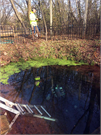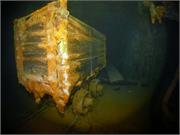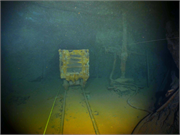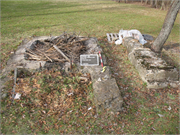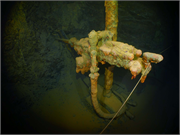| Opened in 1910 by Captain C.T. Roberts following the closing of the Illinois Mine in 1909, the Freedom Mine operated for just over a year, closing in 1911, when its dewatering pumps failed and the subterranean components of the mine flooded. Today the foundations of the compressor, boiler house, engine house, smokestack, and grade for the railroad spur connection remain extant. Beneath the ground, the mineshaft, crosscut, and drifts remain with a remarkable level of integrity, appearing almost exactly as it did the day the mine flooded.
In the early decades of the twentieth century, industrial-scale iron mining in the Baraboo Range created a brief economic boom in the region. The population grew rapidly as workers flocked to newly established mines, and villages sprung up to house miners and their families and provide necessary commercial services. Railroad companies also expanded their rail networks to capitalize on the new mines’ anticipated shipping demands: ore extracted from mines in the Baraboo Iron Range was shipped out of the region for processing. Mining operations also transformed the surrounding landscape and hydrology. Mining engineers struggled against the ever-present threat of flooding. Their attempts to displace the enormous volumes of water drawn into the mine shafts from the bedrock layers surrounding the iron ore deposits created new surface water channels, wetlands, and ponds.
Although the scale of operations at the Freedom Mine was relatively small and short-lived, the features of the site are illustrative of mining practices and operations typical of the Baraboo Range Iron District. This property is the only remaining example of a Baraboo Range iron mine with extant underground workings as well as above ground features that include foundations of the engine house, compressor, boiler house, smokestack, and evidence of the railroad spur connection. Extant features underground in the inundated workings (shafts and drifts) include intact shaft framing (with skip guides) driven down more than 70 feet, dewatering pumps, sump room, post drill, narrow gauge rail that remains in 160 feet of drift workings, and ore cart, and many hand tools used in the mining process which were left at the ready, including various shovels, a pickaxe, tallow candles, several scaling bars and drill steels.
Archaeological investigations within the boundaries of Freedom mine have revealed intact terrestrial features associated with the operation of the mine, and has revealed the remarkably intact remains of the mine’s underground workings, completely preserved, over 70 feet below the surface. To date, little has been known about the subterranean day to day operations of the mines of the Baraboo Iron Range. Freedom Mine gives archaeologists an unprecedented and unique opportunity to study the intricacies of early twentieth century mining operations in Wisconsin, and allow a glimpse of what it was like to work in the mine on a daily basis. With the constant threat of flooding, and the eventual inundation of the mine, archaeologists can begin to understand what occurred just moments before the mine flooded, and understand how the dewatering pumps worked, and how the miners tried a few last ditch efforts to keep the mine dry. As the only known archaeological investigation of a submerged mining site, Freedom Mine offers a unique and extremely rare opportunity to study the remains of Baraboo Range, iron mining operations. Documentation of the extant structures and artifacts at Freedom Mine has provided significant archaeological data on the construction and use of historic iron mines, and on the cultural and material milieu of the times and will continue to contribute to our knowledge in the future. |

